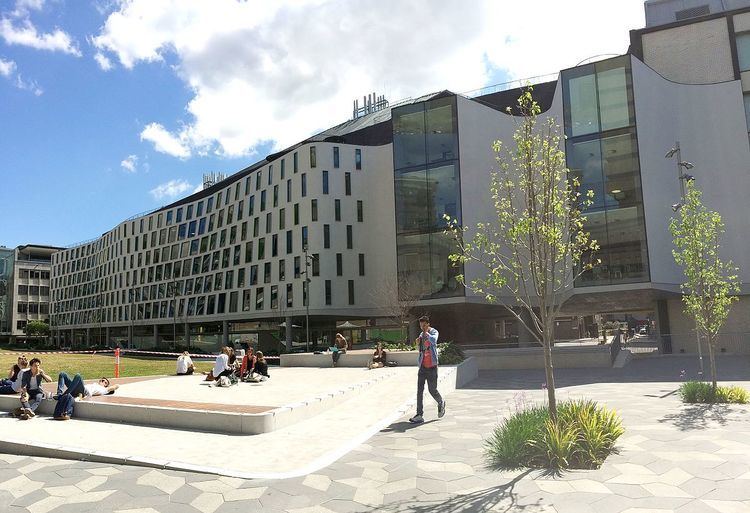Type commercial Completed October 2014 Town or city Sydney | Country Australia Opened October 2014 Inaugurated February 2015 | |
 | ||
Address Corner of Thomas Street and Jones Street, Ultimo Floor area Gross building area: 13,800m2 Usable floor area: 8,900m2
Six levels (including plant) + 3 underground plant and laboratory levels Architect Durbach Block Jaggers in association with BVN Architecture Cost 154 million USD (for the Thomas St Project, which also includes Alumni Green and an underground Library Retrieval System) Similar Reserve Bank of Australia, Salt Pan Creek, Museum of Sydney, Rosehill Gardens Racecourse, Sydney Tramway Museum | ||
The Science Faculty Building is the building housing the Faculty of Science and the Graduate School of Health in the University of Technology Sydney in New South Wales, Australia. It is the third building to be opened under the plan for $154 millions worth of structures designed by Durbach Block Jaggers (DBJ) in association with BVN Architecture constructed by Richard Crookes Constructions. The building is located in the City Campus at 67 Thomas St, Ultimo. It was completed in October 2014 and opened for teaching in February 2015). The building has eight levels that provide spaces for over 1200 staff and students. Three of these floors are distinguished for its state of art teaching, learning and research facilities, which have been located underground.
Contents
- Concept and design
- Spiral stair
- Super Lab
- Green auditorium and flask shaped lighting
- Sustainability
- Notable awards
- References
The organic form of the building is inspiredby the shapes of grove of trees. the undulatory form of the building is inflected by 700 multicoloured coloured, box-like openings piercing the glossy off-white surface of the façade. Considerably, the external cladding has been crafted from more than 75% recycled glass.
Concept and design
The new Science and Graduate School of the Health Building (Building 7) is joined to Building 4. This has been created for the new science and health teaching, learning and research precinct. The faculty is recognised by its natural rendered and organic flowing lines. The building’s exterior is motivated by a grove of ripping trees that accentuate approximately 700 colourful box-style windows, this allows natural light to flow into the building.
The project had conflicting objectives and requirements. Since the faculty was going to be located in the new official heart of the campus the building had to be architecturally distinguished and dignified. However, a tall building on the site would shade the green space of the Alumni Green. The architect's solution was to extend the building horizontally along an est-west axis and to pull the face back at two points along its front elevation (overlooking the Alumni Green), thus fulfilling the brief's solar obligations. DBJ believes that the curved form and white reflective surface provides more light for the interior spaces (it functions like concave lenses). Moreover, the play in scale of the box-style windows and their overlapping pattern not only accentuates the undulating rhythm of the façade but also transforms the three-storey facade into something that appears much more substantial. This ingenious play in scale has given the building a civic presence.
Spiral stair
As the building’s particular aisle, the spiral staircase allows beautiful light from the skylight above. This allows light into the super lab. It consists of 950m2 small pastel tiles from Spain in order to create an active, welcoming and warm atmosphere for students and visitors.
Super Lab
The super lab is the 52-metre-long room which can accommodate over 220 students. It configured into 12 different classrooms, allowing different classes to be held at the same time. There are also other particular labs throughout the building which provide the faculty with maximum flexibility.
Green auditorium and flask-shaped lighting
Besides the spiral staircase and spacious laboratory rooms, the auditorium itself has been designed in a way to involve and inspire students and visitors by entering the space. The architects encourage innovation and creativity by designing conical flask lighting. This flask shape bulbs create a light vibrant green colour. Green is known as the colour of creativity and is also well known as the best colour to create a peaceful mind in order to facilitate the reception of knowledge and information. Moreover, the conical flask lighting, visually reminds visitors about building’s function. Good architecture creates forms and spaces in away that can visually respond to its function.
Sustainability
Sustainability has been considered throughout the building and the significant examples of this green practice can be seen through the roof garden. A green roof for research and the external cladding of the building which is made out of 75% recycled glass. Notably, 27,000-litre rainwater tank supply is recycled water for the rooftop garden and the building’s toilets. The ventilation system has been integrated with natural cooling system which reduces energy use by up to 20%.
The Faculty of Science and Graduate School of Health Building has used many strategies in order to improve sustainability. Critical environmental practices include:
